Yifan Lu
ChronoEdit: Towards Temporal Reasoning for Image Editing and World Simulation
Oct 05, 2025Abstract:Recent advances in large generative models have significantly advanced image editing and in-context image generation, yet a critical gap remains in ensuring physical consistency, where edited objects must remain coherent. This capability is especially vital for world simulation related tasks. In this paper, we present ChronoEdit, a framework that reframes image editing as a video generation problem. First, ChronoEdit treats the input and edited images as the first and last frames of a video, allowing it to leverage large pretrained video generative models that capture not only object appearance but also the implicit physics of motion and interaction through learned temporal consistency. Second, ChronoEdit introduces a temporal reasoning stage that explicitly performs editing at inference time. Under this setting, the target frame is jointly denoised with reasoning tokens to imagine a plausible editing trajectory that constrains the solution space to physically viable transformations. The reasoning tokens are then dropped after a few steps to avoid the high computational cost of rendering a full video. To validate ChronoEdit, we introduce PBench-Edit, a new benchmark of image-prompt pairs for contexts that require physical consistency, and demonstrate that ChronoEdit surpasses state-of-the-art baselines in both visual fidelity and physical plausibility. Code and models for both the 14B and 2B variants of ChronoEdit will be released on the project page: https://research.nvidia.com/labs/toronto-ai/chronoedit
Step-Audio 2 Technical Report
Jul 24, 2025Abstract:This paper presents Step-Audio 2, an end-to-end multi-modal large language model designed for industry-strength audio understanding and speech conversation. By integrating a latent audio encoder and reasoning-centric reinforcement learning (RL), Step-Audio 2 achieves promising performance in automatic speech recognition (ASR) and audio understanding. To facilitate genuine end-to-end speech conversation, Step-Audio 2 incorporates the generation of discrete audio tokens into language modeling, significantly enhancing its responsiveness to paralinguistic information such as speaking styles and emotions. To effectively leverage the rich textual and acoustic knowledge in real-world data, Step-Audio 2 integrates retrieval-augmented generation (RAG) and is able to call external tools such as web search to mitigate hallucination and audio search to switch timbres. Trained on millions of hours of speech and audio data, Step-Audio 2 delivers intelligence and expressiveness across diverse conversational scenarios. Evaluation results demonstrate that Step-Audio 2 achieves state-of-the-art performance on various audio understanding and conversational benchmarks compared to other open-source and commercial solutions. Please visit https://github.com/stepfun-ai/Step-Audio2 for more information.
Cosmos-Drive-Dreams: Scalable Synthetic Driving Data Generation with World Foundation Models
Jun 11, 2025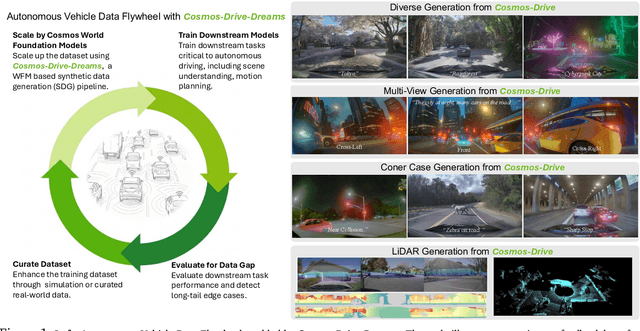
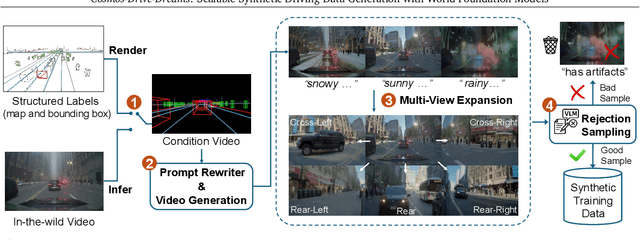
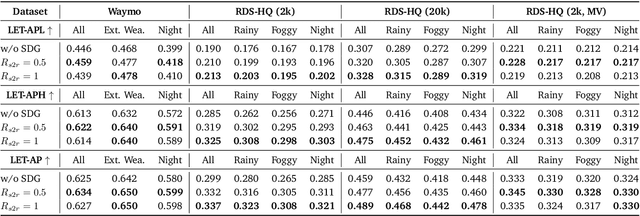
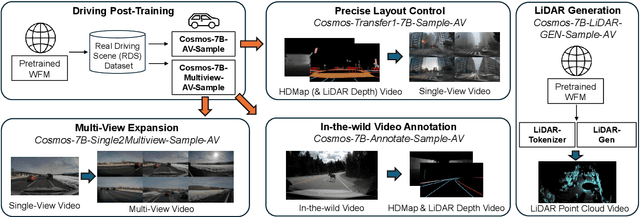
Abstract:Collecting and annotating real-world data for safety-critical physical AI systems, such as Autonomous Vehicle (AV), is time-consuming and costly. It is especially challenging to capture rare edge cases, which play a critical role in training and testing of an AV system. To address this challenge, we introduce the Cosmos-Drive-Dreams - a synthetic data generation (SDG) pipeline that aims to generate challenging scenarios to facilitate downstream tasks such as perception and driving policy training. Powering this pipeline is Cosmos-Drive, a suite of models specialized from NVIDIA Cosmos world foundation model for the driving domain and are capable of controllable, high-fidelity, multi-view, and spatiotemporally consistent driving video generation. We showcase the utility of these models by applying Cosmos-Drive-Dreams to scale the quantity and diversity of driving datasets with high-fidelity and challenging scenarios. Experimentally, we demonstrate that our generated data helps in mitigating long-tail distribution problems and enhances generalization in downstream tasks such as 3D lane detection, 3D object detection and driving policy learning. We open source our pipeline toolkit, dataset and model weights through the NVIDIA's Cosmos platform. Project page: https://research.nvidia.com/labs/toronto-ai/cosmos_drive_dreams
Deep Learning Reforms Image Matching: A Survey and Outlook
Jun 05, 2025Abstract:Image matching, which establishes correspondences between two-view images to recover 3D structure and camera geometry, serves as a cornerstone in computer vision and underpins a wide range of applications, including visual localization, 3D reconstruction, and simultaneous localization and mapping (SLAM). Traditional pipelines composed of ``detector-descriptor, feature matcher, outlier filter, and geometric estimator'' falter in challenging scenarios. Recent deep-learning advances have significantly boosted both robustness and accuracy. This survey adopts a unique perspective by comprehensively reviewing how deep learning has incrementally transformed the classical image matching pipeline. Our taxonomy highly aligns with the traditional pipeline in two key aspects: i) the replacement of individual steps in the traditional pipeline with learnable alternatives, including learnable detector-descriptor, outlier filter, and geometric estimator; and ii) the merging of multiple steps into end-to-end learnable modules, encompassing middle-end sparse matcher, end-to-end semi-dense/dense matcher, and pose regressor. We first examine the design principles, advantages, and limitations of both aspects, and then benchmark representative methods on relative pose recovery, homography estimation, and visual localization tasks. Finally, we discuss open challenges and outline promising directions for future research. By systematically categorizing and evaluating deep learning-driven strategies, this survey offers a clear overview of the evolving image matching landscape and highlights key avenues for further innovation.
Adaptive Detoxification: Safeguarding General Capabilities of LLMs through Toxicity-Aware Knowledge Editing
May 28, 2025Abstract:Large language models (LLMs) exhibit impressive language capabilities but remain vulnerable to malicious prompts and jailbreaking attacks. Existing knowledge editing methods for LLM detoxification face two major challenges. First, they often rely on entity-specific localization, making them ineffective against adversarial inputs without explicit entities. Second, these methods suffer from over-editing, where detoxified models reject legitimate queries, compromising overall performance. In this paper, we propose ToxEdit, a toxicity-aware knowledge editing approach that dynamically detects toxic activation patterns during forward propagation. It then routes computations through adaptive inter-layer pathways to mitigate toxicity effectively. This design ensures precise toxicity mitigation while preserving LLMs' general capabilities. To more accurately assess over-editing, we also enhance the SafeEdit benchmark by incorporating instruction-following evaluation tasks. Experimental results on multiple LLMs demonstrate that our ToxEdit outperforms previous state-of-the-art methods in both detoxification performance and safeguarding general capabilities of LLMs.
CoMatch: Dynamic Covisibility-Aware Transformer for Bilateral Subpixel-Level Semi-Dense Image Matching
Mar 31, 2025Abstract:This prospective study proposes CoMatch, a novel semi-dense image matcher with dynamic covisibility awareness and bilateral subpixel accuracy. Firstly, observing that modeling context interaction over the entire coarse feature map elicits highly redundant computation due to the neighboring representation similarity of tokens, a covisibility-guided token condenser is introduced to adaptively aggregate tokens in light of their covisibility scores that are dynamically estimated, thereby ensuring computational efficiency while improving the representational capacity of aggregated tokens simultaneously. Secondly, considering that feature interaction with massive non-covisible areas is distracting, which may degrade feature distinctiveness, a covisibility-assisted attention mechanism is deployed to selectively suppress irrelevant message broadcast from non-covisible reduced tokens, resulting in robust and compact attention to relevant rather than all ones. Thirdly, we find that at the fine-level stage, current methods adjust only the target view's keypoints to subpixel level, while those in the source view remain restricted at the coarse level and thus not informative enough, detrimental to keypoint location-sensitive usages. A simple yet potent fine correlation module is developed to refine the matching candidates in both source and target views to subpixel level, attaining attractive performance improvement. Thorough experimentation across an array of public benchmarks affirms CoMatch's promising accuracy, efficiency, and generalizability.
Cosmos-Transfer1: Conditional World Generation with Adaptive Multimodal Control
Mar 18, 2025Abstract:We introduce Cosmos-Transfer, a conditional world generation model that can generate world simulations based on multiple spatial control inputs of various modalities such as segmentation, depth, and edge. In the design, the spatial conditional scheme is adaptive and customizable. It allows weighting different conditional inputs differently at different spatial locations. This enables highly controllable world generation and finds use in various world-to-world transfer use cases, including Sim2Real. We conduct extensive evaluations to analyze the proposed model and demonstrate its applications for Physical AI, including robotics Sim2Real and autonomous vehicle data enrichment. We further demonstrate an inference scaling strategy to achieve real-time world generation with an NVIDIA GB200 NVL72 rack. To help accelerate research development in the field, we open-source our models and code at https://github.com/nvidia-cosmos/cosmos-transfer1.
RoCo-Sim: Enhancing Roadside Collaborative Perception through Foreground Simulation
Mar 13, 2025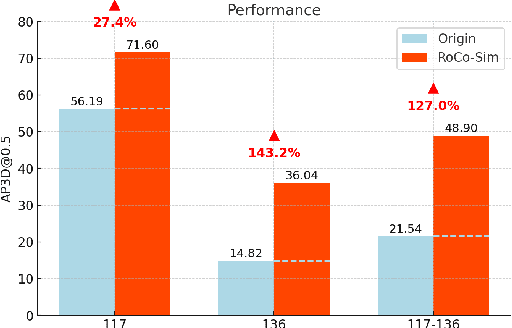
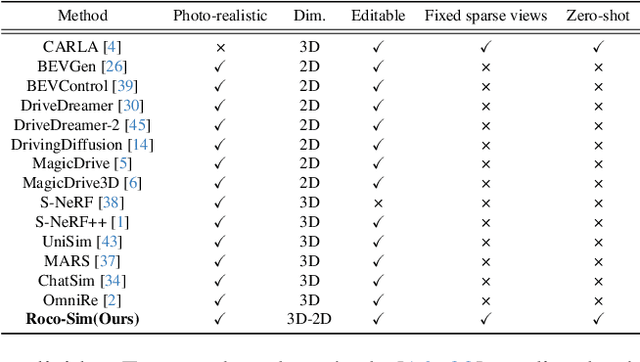
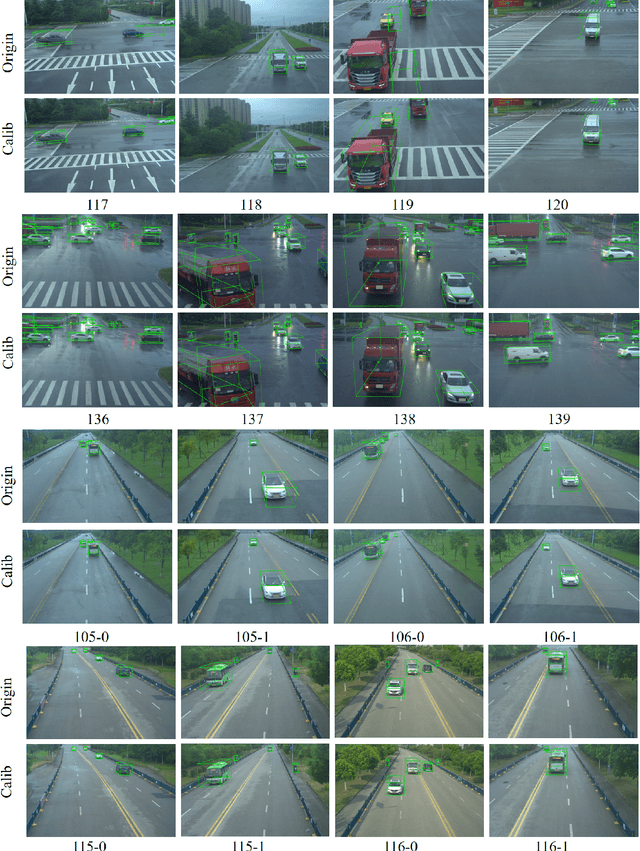
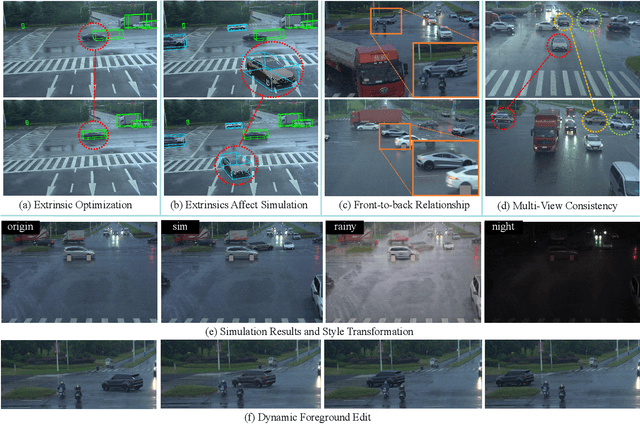
Abstract:Roadside Collaborative Perception refers to a system where multiple roadside units collaborate to pool their perceptual data, assisting vehicles in enhancing their environmental awareness. Existing roadside perception methods concentrate on model design but overlook data issues like calibration errors, sparse information, and multi-view consistency, leading to poor performance on recent published datasets. To significantly enhance roadside collaborative perception and address critical data issues, we present the first simulation framework RoCo-Sim for road-side collaborative perception. RoCo-Sim is capable of generating diverse, multi-view consistent simulated roadside data through dynamic foreground editing and full-scene style transfer of a single image. RoCo-Sim consists of four components: (1) Camera Extrinsic Optimization ensures accurate 3D to 2D projection for roadside cameras; (2) A novel Multi-View Occlusion-Aware Sampler (MOAS) determines the placement of diverse digital assets within 3D space; (3) DepthSAM innovatively models foreground-background relationships from single-frame fixed-view images, ensuring multi-view consistency of foreground; and (4) Scalable Post-Processing Toolkit generates more realistic and enriched scenes through style transfer and other enhancements. RoCo-Sim significantly improves roadside 3D object detection, outperforming SOTA methods by 83.74 on Rcooper-Intersection and 83.12 on TUMTraf-V2X for AP70. RoCo-Sim fills a critical gap in roadside perception simulation. Code and pre-trained models will be released soon: https://github.com/duyuwen-duen/RoCo-Sim
GEN3C: 3D-Informed World-Consistent Video Generation with Precise Camera Control
Mar 05, 2025Abstract:We present GEN3C, a generative video model with precise Camera Control and temporal 3D Consistency. Prior video models already generate realistic videos, but they tend to leverage little 3D information, leading to inconsistencies, such as objects popping in and out of existence. Camera control, if implemented at all, is imprecise, because camera parameters are mere inputs to the neural network which must then infer how the video depends on the camera. In contrast, GEN3C is guided by a 3D cache: point clouds obtained by predicting the pixel-wise depth of seed images or previously generated frames. When generating the next frames, GEN3C is conditioned on the 2D renderings of the 3D cache with the new camera trajectory provided by the user. Crucially, this means that GEN3C neither has to remember what it previously generated nor does it have to infer the image structure from the camera pose. The model, instead, can focus all its generative power on previously unobserved regions, as well as advancing the scene state to the next frame. Our results demonstrate more precise camera control than prior work, as well as state-of-the-art results in sparse-view novel view synthesis, even in challenging settings such as driving scenes and monocular dynamic video. Results are best viewed in videos. Check out our webpage! https://research.nvidia.com/labs/toronto-ai/GEN3C/
Knowledge Editing with Dynamic Knowledge Graphs for Multi-hop Question Answering
Dec 18, 2024



Abstract:Multi-hop question answering (MHQA) poses a significant challenge for large language models (LLMs) due to the extensive knowledge demands involved. Knowledge editing, which aims to precisely modify the LLMs to incorporate specific knowledge without negatively impacting other unrelated knowledge, offers a potential solution for addressing MHQA challenges with LLMs. However, current solutions struggle to effectively resolve issues of knowledge conflicts. Most parameter-preserving editing methods are hindered by inaccurate retrieval and overlook secondary editing issues, which can introduce noise into the reasoning process of LLMs. In this paper, we introduce KEDKG, a novel knowledge editing method that leverages a dynamic knowledge graph for MHQA, designed to ensure the reliability of answers. KEDKG involves two primary steps: dynamic knowledge graph construction and knowledge graph augmented generation. Initially, KEDKG autonomously constructs a dynamic knowledge graph to store revised information while resolving potential knowledge conflicts. Subsequently, it employs a fine-grained retrieval strategy coupled with an entity and relation detector to enhance the accuracy of graph retrieval for LLM generation. Experimental results on benchmarks show that KEDKG surpasses previous state-of-the-art models, delivering more accurate and reliable answers in environments with dynamic information.
 Add to Chrome
Add to Chrome Add to Firefox
Add to Firefox Add to Edge
Add to Edge